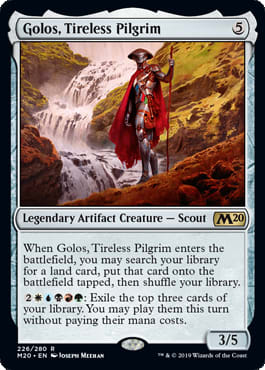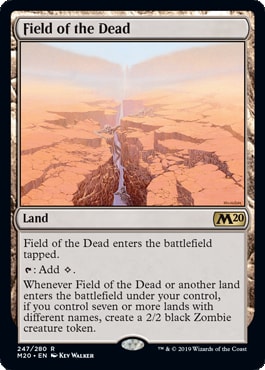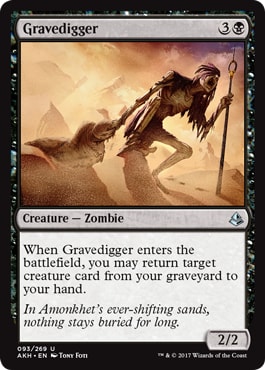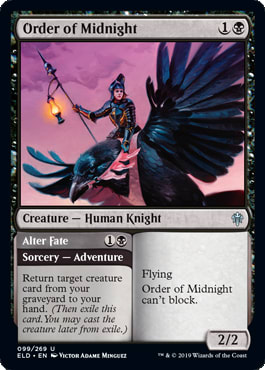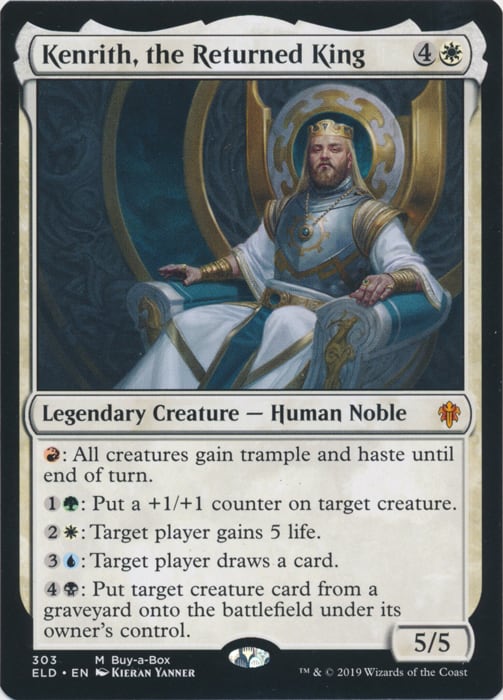Part 1: Lyra Dawnbringer Picked a Good Time to Rotate Out
As of this week, notable Baneslayer Angel wannabe Lyra Dawnbringer left the Standard-legal rotation for greener pastures (or bluer skies) in Historic or the odd one-of Modern sideboard slot. She couldn't have picked a better time of it.
Why, you ask? Let's remember that...
- "Baneslayers
- "Mulldrifters
"Baneslayers are creatures where the value is in the creature itself. Mulldrifters are creatures that give you value outside of the creature.
"... There are a few creatures that are truly both which are quite rare and are normally identifiable by the word "Titan" appearing on the card. Emeria Angel, Cunning Sparkmage, Oracle of Mul Daya, and Ulamog are examples. A good rule of thumb is: 'If you care about killing it it's a Baneslayer.' If killing it loses value it tends to be a Mulldrifter."
-Patrick Chapin, Innovations - The Innovator's Guide To New Phyrexia Standard: Part 2
One of the reasons that Standard seems so odd right now is that, at least at the present time, there is an enormous incentive to playing Mulldrifters rather than Baneslayers. There has long been a balance between the two types of cards; even if they often played together.
But right now, one week in, the top tables of the first big Standard event were all Mulldrifter, all the time.
Cards like Arboreal Grazer and Agent of Treachery are classic Mulldrifters. One way you know is if you'd ask yourself if you'd ever play a 0/3 creature for an actual mana, or if your mouth ever waters at the prospect of spending seven for a 2/3 that doesn't have deathtouch, lifelink, or a pair of earbuds in its head shot silhouette. Another is that pleasant feeling of surprise you feel when you realize your Grazer can bounce away a Thief of Sanity or your Agent can gobble up the opponent's Field of the Dead token and live to do it again next turn. That merest whisper of competence on the battlefield smacks of Mulldrifter. Mulldrifters they are! Mulldrifters and Titans, of course.
Golos, namesake and centerpiece of the top strategy (top three strategies?) is in fact a Titan. For five mana it gives you a powerful Primeval Titan-like ability, and then if you don't kill it, it buries you in value over time like a Consecrated Sphinx. Titan.
It's not that we're not used to playing against Mulldrifters. We're largely just not used to playing against only Mulldrifters. (Titans are Mulldrifters-plus, remember). It's not that we don't have removal if we want it. It's just that using removal sucks. If your stomach doesn't turn a little pointing a Witch's Vengeance at an Agent of Treachery. Yuck. Never mind! We both know your stomach turned just reading those sentences.
Part II: The Problem with Field of Ruin
This was, once upon a time, the scariest deck of all time:
Trix | 2000 | Scott McCord, 2nd Place GP-Philadelphia 2000
- Instants (19)
- 1 Contagion
- 1 Hoodwink
- 2 Brainstorm
- 3 Vampiric Tutor
- 4 Dark Ritual
- 4 Demonic Consultation
- 4 Force of Will
- Enchantments (8)
- 4 Illusions of Grandeur
- 4 Necropotence
- Artifacts (4)
- 4 Mana Vault
- Lands (21)
- 3 Island
- 6 Swamp
- 4 Gemstone Mine
- 4 Underground River
- 4 Underground Sea
- Sideboard (15)
- 1 Hoodwink
- 2 Contagion
- 4 Phyrexian Negator
- 3 Annul
- 2 Unmask
- 3 Hydroblast
Full-on Trix!
This was probably the most powerful version (and there were many powerful versions); with four copies each of Mana Vault, Dark Ritual, Necropotence, Force of Will, and Demonic Consultation. A deck whose engine cards were so good it could only fit two Brainstorms and three Vampiric Tutors!
Trix had many failings that took many rounds of bannings and rotations to correct. It was widely misunderstood. On the one hand it was just all the good - nay all the best - cards in one list. Like I said, two Brainstorms. Shrug emoji.
To fit all those powerful card drawing, card selection, mana acceleration, and defensive cards you had to play a very compact actual way to win. In this case it was Illusions of Grandeur + Donate. The opponent suddenly had your Illusions of Grandeur (but not the benefit of 20 extra life) and would presumably die if he couldn't play the requisite upkeep.
There were many angles by which Trix could be attacked. You could gain 1 or more life, putting you to 21. You could play an Elvish Lyrist or Seal of Cleansing, which would allow you to destroy Illusions of Grandeur before Trix could give it to you... Or better yet, with 20 life on the stack! They'd lose 20 before gaining 20! That would be a riot.
And against less experienced Trix players, these angles were sometimes successful. Of course a deck that had just gained 20 life and had Necropotence in play could often just combo up a second time, or evade your silly "only draws one card per turn" interaction with some mashup of Duress, Force of Will, Hoodwink, and Contagion.
Silly Rabbit.
One problem with Trix was that it played all the best cards. Other decks played good cards, but none played as many as Trix did. Skull Catapult had a lot of the Black cards. Tinker had the artifact acceleration and some of the Blue ones. Draw-Go played the permission and frankly made better use of (probably more copies of) Brainstorm. But none had as many - or broke them as violently - as Trix.
Of course this was also a two-card combination deck. You could prepare for all the broken stuff but might not be able to beat someone who paid four mana for Illusions, paid two on upkeep, hit his fifth land drop, and just gave it to you using entirely basic lands.
Neither problem was the real problem.
Like I said, other decks played good cards. Like I said, this one had many areas where it could be interacted with. The real problem WAS THAT THEY GAINED 20 LIFE IN THE MIDDLE OF THEIR COMBO.
You had to deal with x.
You had to deal with y.
And if everything worked out... They were also at 40.
That was the rassin' frassin' problem with Trix.
Like the weird imbalance of Mulldrifters (and Titans) over Baneslayers, Field of the Dead offers a Trix-like dilemma:
It's not that Field of the Dead is so great. I mean, it is; but it's a land, and they have to play a bunch of inefficient lands (not to mention lots of lands generally) to make it work.
It's not that the 2/2 creatures can't be interacted with. There's no shortage of direct ways. Legion's End, for example, is an extremely efficient one.
It's that they gain 40 life in the middle of the game. Not kidding. The value presented by the zombies via non-spell slots is very much like Trix gaining a ton of life. Basically, in the absence of Field of Ruin, even prepared non- or anti-Golos decks are committing spell slots to deal with land slots or the residue of land slots. It just sucks.
Field of the Dead is itself basically a Titan.
Part III: Baneslayers Mulldrifters one More Time
But MichaelJ! You might scream.
There are Baneslayers! Not everyone is a Mulldrifter!
I suppose that's true. But I'd argue that this is a big creature right now.
It has a body to it. I mean, it probably drew a card - even if Belle isn't much of a card - on the way in. The best of the Adventure guys are Titan-reminsicent; but I'd argue that the average (even average playable) one is basically a Mulldrifter.
What do you call this?
According to Patrick Chapin, this is just a Gravedigger you can put a down payment on.
Part IV: Building, Fast and Slow
I can't recall a Standard that looked like the one we have before us. I haven't actually asked Jamie Wakefield, but I probably should. I assume he'd hate it.
Yet!
This is a format where fatties like Golos, Kenrith, Beanstalk Giant, and Realm-Cloaked Giant define size and end games. It's a format where the highest performing decks scoff at 26 lands for 28 or even 29. It's a format where Green isn't just good, fundamentally Green stuff like Circuitous Route is essential to the center of the game.
Isn't this the kind of format that players who want a developed, developing, not-compact beatdown / tempo-reliant / combo-drowned Standard based on the tried and true fundamentals of Magic: The Gathering should adore?
Remember when y'all thought Esper Dance was going to be the problem in Standard? Boy were those simpler times...
— Bryan Gottlieb (@BryanGo) October 5, 2019
I'm not so ready to give up yet. It's not like an Aggro-Control deck is the best deck in Standard. Now that is another story.
In a format that really and truly is about development on the fundamentals... Making land drops and (eventually) attacking with creatures, all the fun tends to be spoiled when someone figures out a real combo deck, but that seems a bit off just now. Instead I'll remind you of an aphorism we learned way back in Invasion Block Constructed testing:
This sounds obvious but it's kind of counterintuitive. Decks that build to big end games or big x-spells tend to leave the little chip shots behind. But if two decks are trying to do the same thing, that changes a bit. If you got in for a little damage early, your big finish will have to be a little less big than theirs to do the same thing.
This is literally true for Golos decks in the current Standard.
You can approach this one of two ways:
- Do something different.
- Do something quicker.
Sultai Golos | Eldraine Standard | Zach Allen, SCG Team Open Philadelphia
- Creatures (17)
- 2 Agent of Treachery
- 2 Arboreal Grazer
- 2 Yarok, the Desecrated
- 3 Hydroid Krasis
- 4 Golos, Tireless Pilgrim
- 4 Risen Reef
- Instants (7)
- 3 Once Upon a Time
- 4 Growth Spiral
- Sorceries (7)
- 3 Find // Finality
- 4 Circuitous Route
- Lands (29)
- 2 Forest
- 2 Island
- 2 Swamp
- 1 Azorius Guildgate
- 1 Castle Locthwain
- 1 Dimir Guildgate
- 1 Dismal Backwater
- 1 Golgari Guildgate
- 1 Jungle Hollow
- 1 Rakdos Guildgate
- 1 Simic Guildgate
- 1 Temple of Malady
- 1 Temple of Mystery
- 1 Thornwood Falls
- 1 Watery Grave
- 2 Breeding Pool
- 2 Overgrown Tomb
- 3 Fabled Passage
- 4 Field of the Dead
Allen's Sultai deck tops up on Yarok, the Desecrated. This is something different. It's not bound by the same top end as other Golos decks. In fact, this deck's Golos is apt to accomplish twice the mischief! Pre-sidedboarded for the mirror, double triggers on Agent of Treachery are more than doubly valuable. Not only can you steal two things (either one probably arguably the best thing the opponent has going on), you might actually accumulate enough permanents to get off the Agent's other line.
In the case that you're not doing something different, I'd encourage you to do something faster. Doing the same thing but not faster is either going to put you in a neutral position when you don't have to be or concede the speed factor to the opponent.
Bant Golos | Eldraine Standard | Jonathan Rosum, SCG Team Open Philadelphia
- Creatures (18)
- 1 Fae of Wishes
- 1 Kenrith, the Returned King
- 2 Arboreal Grazer
- 3 Beanstalk Giant
- 3 Realm-Cloaked Giant
- 4 Golos, Tireless Pilgrim
- 4 Hydroid Krasis
- Planeswalkers (3)
- 3 Oko, Thief of Crowns
- Instants (7)
- 3 Once Upon a Time
- 4 Growth Spiral
- Sorceries (4)
- 4 Circuitous Route
- Lands (28)
- 1 Plains
- 1 Swamp
- 2 Forest
- 2 Island
- 1 Azorius Guildgate
- 1 Blossoming Sands
- 1 Boros Guildgate
- 1 Dimir Guildgate
- 1 Hallowed Fountain
- 1 Overgrown Tomb
- 1 Selesnya Guildgate
- 1 Simic Guildgate
- 1 Temple of Mystery
- 1 Thornwood Falls
- 1 Tranquil Thicket
- 2 Breeding Pool
- 2 Temple Garden
- 3 Fabled Passage
- 4 Field of the Dead
- Sideboard (15)
- 3 Devout Decree
- 3 Agent of Treachery
- 2 Veil of Summer
- 1 Prison Realm
- 1 Jace, Wielder of Mysteries
- 1 Time Wipe
- 2 Assassin's Trophy
- 2 Negate
Kenrith probably seems like industry standard for Bant decks at this point, but it was not played across the board. Given it will be going forward, you might want to figure out a way to get even faster.
Kenrith might not seem like a "fast" card, but contextually it not only potentially gives you a massive initiative boost [on the last turn] if you have multiple copies of Field of the Dead triggering, the combination of haste and trample can make Beanstalk Giant immediately lethal. So you not only deploy the Beanstalk Giant and attack with it, an instant speed Assassin's Trophy might close the book even if the opponent has a commensurately huge blocker! This play is available even Game 1 thanks to Fae of Wishes.
Part V: Everything Old is New Again
I just thought I'd throw together a short list of not-new not-Throne of Eldraine cards that I believe have jumped in value due to the context of the rest of the format. Enjoy!
- Woodland Champion - Note that this card loves tokens, not necessarily token creatures. That means that midgame Gilded Goose draws feel less unacceptable, and Oko (as good as he already is) becomes a source of power as well as materiel. I was really surprised how quickly this creature started to perform. If you're looking for a plug to your mana curve, I think you will be, too.
- Ashiok, Dream Render - This card has got multiple layers of new life. Not only is it just slightly cheap enough to get down under Circuitous Route, Field of the Dead decks are incentivized to hold onto lands like Fabled Passage until the late game in order to double their potential triggers. Ashiok does a nice good number on the slow holders! In addition, it has some absolutely relevant text against Dance of the Manse and the Doom Foretold decks.
- Tamiyo, Collector of Tales - People just think about this as a card drawing and recursion engine, but Tamiyo has a heck of a static ability... If people are playing Doom Foretold. Holy one-sided enchantment, Batman! Holy shooting yourself in the foot, Batman! Awesome, right? Part of the reason Mulldrifters are so popular in Stnadard is that they make for great sandbags against Doom Foretold. You already got your value, plus they passively defend your good permanents. Golos decks probably don't need Tamiyo (despite being in-color) but I'm glad I have the technology for other archetypes.
- Ethereal Absolution - The mana's not easy-easy, but if you can fire off a Golos activation, you can cast this. Your 2/2 tokens are big, theirs are much smaller. Plus, you get something to do with your mana at the end of their turn if you're, say, locked under their Teferi or your own Fires.
LOVE
MIKE
















